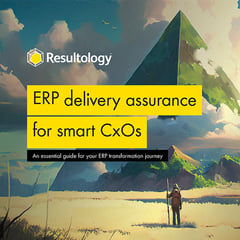WHAT IS ERP ADOPTION?
Implementing a new ERP system is a significant financial investment but whether it is leveraged to release its full potential is dependent on how widely the business users embrace it.
Getting users on board is fundamental to the success of your implementation and the longer term success and development of your ERP solution.
How successfully you manage the business change and the adoption of the system by your user base is key.
System Adoption needs to be front and centre of our implementation, but what does that mean?
It's easy to explain - it’s about accepting or starting to use something new.
Adoption may require some behavioural change but less than that required for a ‘transformational’ change such as an organisational redesign.
It’s simple really if we don’t bring the users on the ERP journey with us chances are they will be resistant to the change and less likely to adopt our new processes and solution. Keep them informed, updated and involved then they have a vested interest in making it a success.
Long and short of it is if the business don’t adopt your ERP solution, you won’t drive the change and realise the business benefits you expected. Effectively managing the change and the adoption of the change is pivotal to the success of any ERP implementation. This needs to be done throughout the project phases from the initial kickoff discussions right through to post go live.
Adoption has a number of facets that we need to consider.
ERP CHANGE MANAGEMENT
As human beings we are naturally resistant to change, although we hate to admit it we are generally creatures of habit and often the thought of change even if it’s going to improve things makes us scared and unsure.
Our default position in relation to change is wariness, wariness that the change will be for the worse until proven otherwise. We need to be convinced, we need to be cajoled and we need to feel listened to.
The introduction of a new ERP solution brings about potentially huge amounts of change within the business.
There’s the new technology we need to get our heads around, the ERP system itself and how it functions. How to navigate the screens, what buttons need to be pressed. Chances are our business processes and ways of working will have changed in some way.
We need to understand how this impacts day to day activities; how do I still get my job done?
There may be changes to our Operating Model which impact people’s roles and responsibilities, this can bring huge amounts of uncertainty for individuals and leave them feeling vulnerable and hesitant. We need to be sensitive to this otherwise small concerns can escalate out of all proportion.
There’s a good chance when introducing a new ERP solution we will be introducing a new support model, we might be moving to use a third party supplier, we might be establishing an internal support team.
Again this may impact the way in which we operate...
This all causes uncertainty from a user perspective. We need to prepare the business for dealing with this change.
We need to help them manage this change. Because if we don’t it will be an unmitigated disaster.
Change Management is the term that describes the approaches for preparing, supporting, and helping individuals, teams, and organisations in making organisational change.
There are various approaches to Change Management that can be implemented, but there are some key themes that will help to lessen the impact of the change. Have a clear understanding of the impact of the change. Understand the boundaries and what is going to be impacted and as such needs to be managed. Until you know the scope of the change, you can’t evaluate the impact of the change and you can’t mitigate the risk of the change.
Someone senior in the business needs to be the sponsor and advocate of the change to get everyone in the business on board. They need to visibly sponsor and promote the change. The business needs to understand the importance of the program. They are going to have to invest a lot of time and effort to make it a success. Time that they probably don’t have to spare, so they need to understand why they are doing it and what’s in it for them.
A clear communication strategy that keeps everyone up to date on where things are up to and the progress being made. And of timelines that may impact them so they can plan accordingly. Briefing packs, webinars, videos, demos all help to spread the word.
A network of change agents responsible for promoting the change. Key individuals within the business who will advocate and promote the change. Subject matter experts who can see and understand the benefits of the change but who also understand the business to voice any concerns and ensure the solution is fit for purpose.
Great business engagement from early in the process. Make them feel like they have a voice and that they are empowered to raise questions and concerns.
They need to feel like they are being listened to and understood.
Engagement at every step of the process helps to reduce their anxiety and gives them a voice.
They can see the progress and start to understand the implications of the change early so they can prepare.
Excellent education and training, and an obsession with showcasing and celebrating early success.
Taking every opportunity to use real examples and real people from early adoption. This helps to promote business buy in and user engagement.
ERP TRAINING
Implementing a new ERP system can have a significant impact on the business and its employees, changing the way in which they do things.
One of the biggest challenges when rolling out a new ERP system is training, upskilling and coaching your staff in how to use the new system and technologies.
How to do it, when to do it and how to get it right. Timing and content is everything, train them too early and they’ll forget it, train them too late and they’ll be unprepared and panic.
It’s important to get it right the first time to smooth the implementation and keep the workforce motivated and engaged.
It sounds pretty self-evident that effectively training the users in how to use the new system would be important.
Let’s face it though, how many times do you read the user manual when you buy something new?
It’s amazing how often training is not given enough thought on ERP projects, causing stress on the run up to go live as the users start to panic that they won’t be able to do their jobs, then unnecessary noise after go live when things are more difficult and they don’t know how to do their jobs.
So how do you get it right?
Involving the business users throughout the project is a good way of ensuring they are actively engaged. This allows for coaching along the way, lets them see the software in action and lets them ask questions about how it will impact them, demonstrating how things will be different in the future.
Make training an integral part of your ERP project. Keeping the users involved helps to promote a culture of continued learning, as well as keeping them motivated and onboard. That way there’s no nasty surprises when it comes to training as they already know what to expect.
Your approach to user training needs careful consideration and will need a strategy clearly defined to support it. It’s not easy and will take time and a lot of discussion.
You’ll need to carry out a detailed analysis of the training requirements that considers the training needs of each role in the organisation to operate the new system and the new business processes.
It’s unlikely that a one-size fits all approach to training will work.
Employees in different areas of the organisation will require different levels of training support depending on their level of experience and the role they do.
Excellent education and training should be an obsession on your ERP Project.
Get it right and it’s a chance to showcase and celebrate the project’s success and to improve user adoption.
Take every opportunity to educate and coach, get employees on board and give your ERP project a real chance of success.
HYPERCARE FOR ERP
Once our ERP solution is live and has cutover to Production we move into hypercare or post go-live support.
Hypercare is the final project state whereby the project team supports the business in operating the live system for an agreed period of time.
This is the period of time is takes us to stabilise the ERP solution within the business, to ensure that outstanding issues are resolved and that the system is fit for purpose from a business perspective.
Does the ERP solution work when it’s used in anger by volumes of business users? Does the theory translate successfully to reality? Have we delivered what we said we would? How long hypercare lasts varies and is dependent on a number of factors. These factors need to be carefully planned and decided in the planning stages of your project and should be agreed with your Systems Integrator. As a minimum hypercare will generally last at least one full month cycle.
Once hypercare is complete your solution will transition into ‘Business As Usual Support’, your project team disappear and move onto pastures new. If these transition activities aren’t carefully planned and executed then there’s a risk that critical solution knowledge is lost when your Systems Integrator and Project Resources walk out the door.
Knowledge transfer is a critical activity within the hypercare phase.
During the project a transition strategy document will have been agreed that includes the principles and approach of transition into support. It will outline what the post go live support organisation will look like and how we ensure the support organisation is capable of supporting and developing the solution ongoing.
During the planning phase project exit criteria and support entry criteria will have been jointly agreed between the project team and the support team. These criteria will need to be met in order for hypercare to exit. Common criteria include stability in the number of incidents being raised, number of live defects and number of customer queries being stable.
The support organisation will be confident in their ability from both a capability and resourcing point of view to accept the system into support. We need to empower them and set them up for success.
At that point in time the hypercare team can move on.
In some instances project team members will be retained as part of the support organisation until knowledge is embedded.
Once hypercare is complete then your SI will have likely met their contractual obligations.
They will be ramping down from your project and moving onto their next piece of work.
Before you sign off hypercare you need to be sure that all your expectations have been met and that there are no high priority defects outstanding.
You need to make sure that any unresolved defects are appropriately handed over to internal resources or to the support organisation who will be supporting the system ongoing.
NEXT: LIFE AFTER GO-LIVE
Discover how to start seeing the benefits of your ERP project once you Go-Live.












